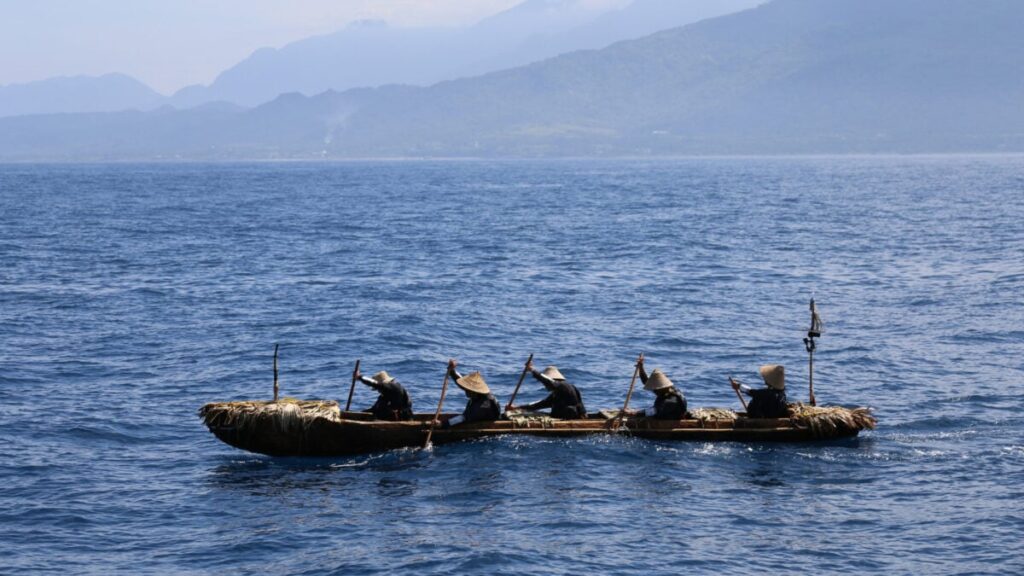
TAIWAN – A daring archaeological experiment has shed new light on ancient seafaring techniques, as researchers successfully navigated one of Earth’s most formidable ocean currents using Stone Age technology.
Breaking: Successful Voyage Across the Kuroshio Current
Archaeologists have long debated how early humans reached the Ryukyu Islands off Japan’s southwestern coast, a journey estimated to have occurred between 35,000 and 27,500 years ago. The recent expedition aimed to solve this mystery by recreating the conditions of a Paleolithic voyage.
Using replicas of tools from the Upper Paleolithic period, researchers in Japan constructed a dugout canoe. They successfully crossed the 68.4-mile-wide (110-kilometer) strait between Taiwan and Yonaguni Island, traversing the powerful Kuroshio current in approximately 45 hours.
“Our 7.5-meter-long dugout, manufactured with edge-ground stone axes, was speedy and durable enough to cross this strait,” the researchers stated in their study published in Science Advances.
Immediate Impact: Insights into Ancient Navigation
The successful voyage offers a plausible explanation for how people in present-day Taiwan may have reached the islands tens of thousands of years ago. The experiment highlighted the potential of early functional boats and the advanced navigational skills of prehistoric peoples.
One of the primary challenges in studying ancient seafaring is the absence of direct archaeological evidence, as organic materials like wood have disintegrated over time. This makes experimental archaeology a crucial method for understanding historical practices.
Key Details Emerge: The Experiment’s Design and Execution
Since 2013, University of Tokyo anthropologist Yousuke Kaifu and his team have been attempting to reach the Ryukyu Islands without modern navigation tools. Previous attempts using reed-bundle and bamboo rafts were unsuccessful, leading to the innovative design of a canoe crafted from a hollowed and fire-charred Japanese cedar tree.
“Given the absence of archaeological remains of Pleistocene watercraft, we narrowed down the possible Paleolithic seagoing craft by referencing Holocene archaeological and ethnographic records,” the researchers explained.
By the Numbers: The Journey’s Specifications
- Distance Traversed: 68.4 miles (110 kilometers)
- Time Taken: Approximately 45 hours
- Crew Members: Five
- Canoe Length: 7.5 meters
Expert Analysis: The Implications of the Study
The study underscores the sophisticated capabilities of Paleolithic peoples, challenging the perception of them as “primitive.” The researchers’ work suggests that early humans were adept navigators, capable of undertaking complex sea voyages with limited technological resources.
Computer models developed by the team simulated crossings under Late Pleistocene oceanic conditions, further supporting the feasibility of such journeys. The simulations emphasized the importance of starting points, directional strategies, and celestial navigation.
“Paleolithic people are often regarded as ‘inferior’ due to their ‘primitive’ culture and technology. In contrast, our work highlighted that they accomplished extraordinary feats with the rudimentary technology available to them,” the researchers noted.
What Comes Next: Future Research Directions
While experimental archaeology cannot replace direct archaeological evidence, it offers valuable insights into prehistoric life. The team’s findings contribute to a growing body of research using hands-on methods to explore ancient human capabilities.
The success of this experiment may prompt further studies into the seafaring techniques of other ancient cultures, potentially leading to new discoveries about human migration and adaptation.
The announcement comes as researchers continue to explore the complexities of early human history, with each new finding offering a deeper understanding of our ancestors’ ingenuity and resilience.







